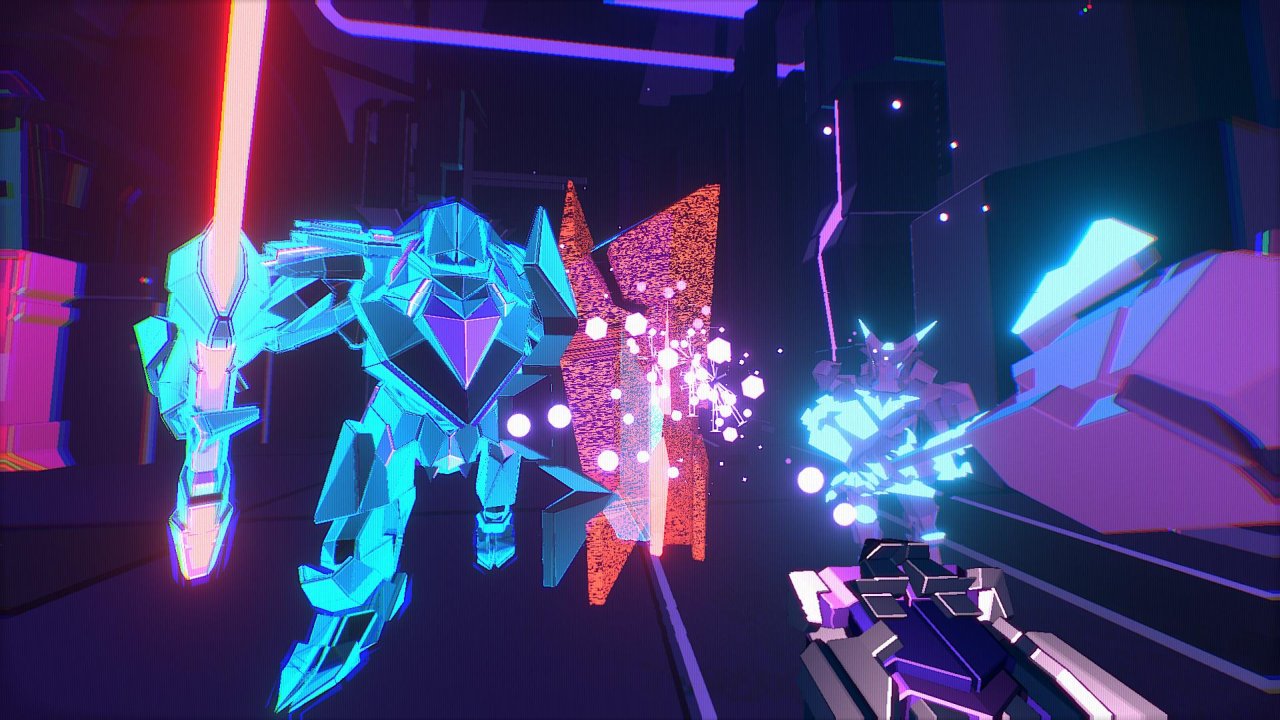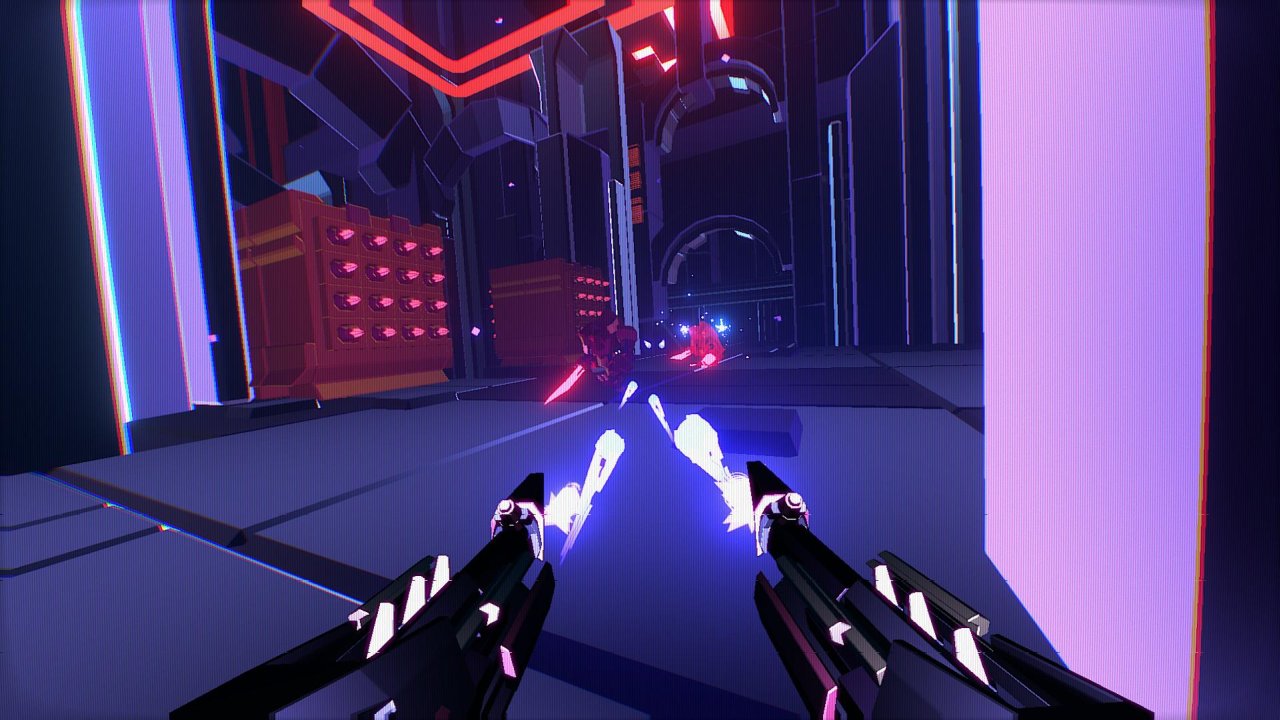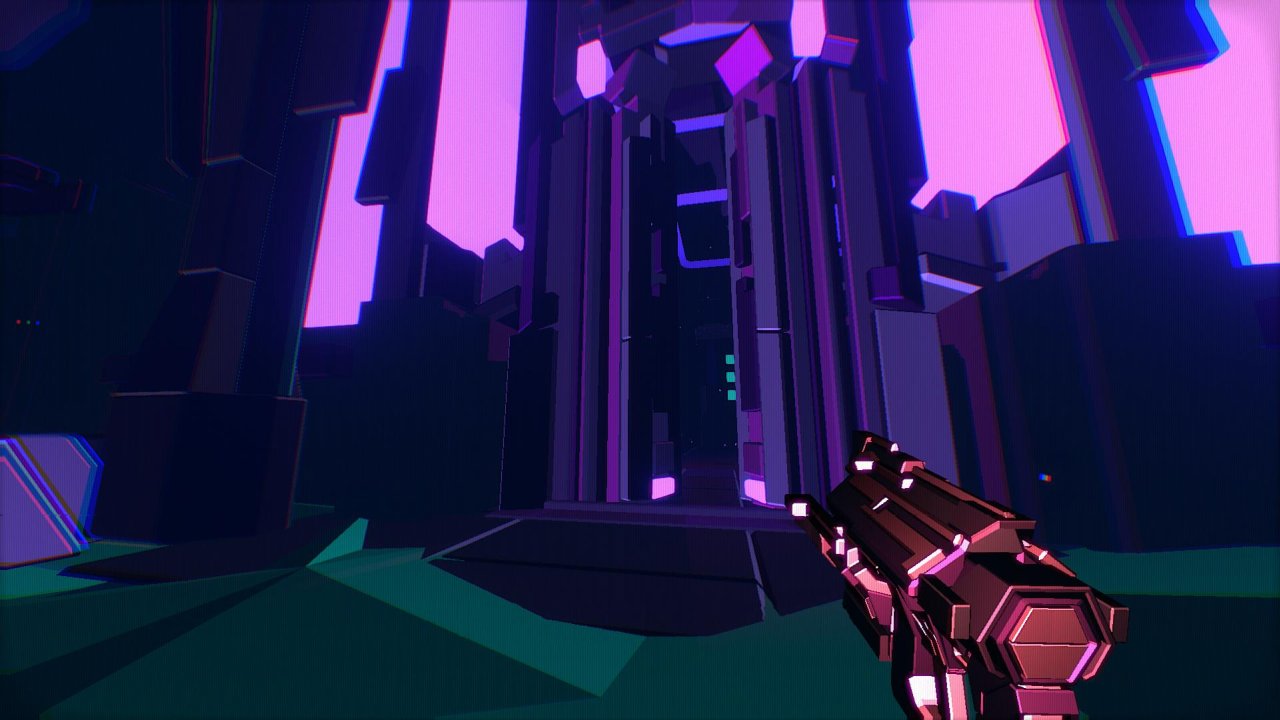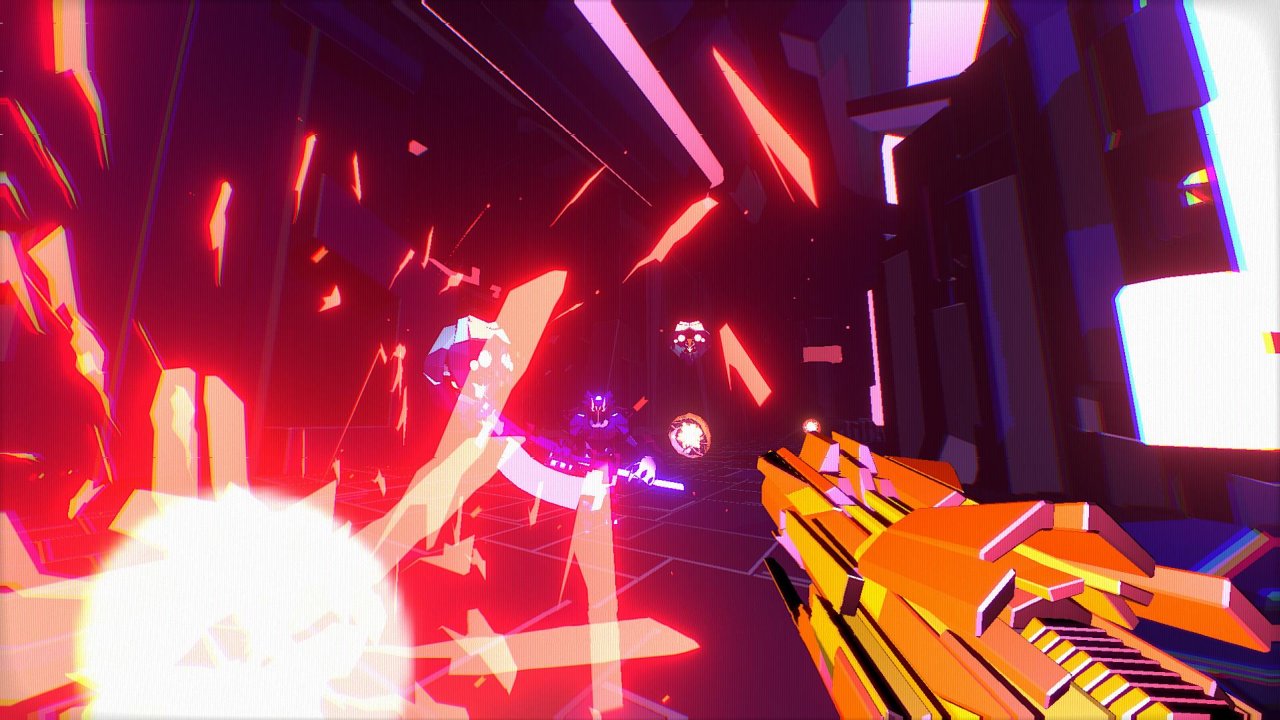Desync Review
Sync or swim
Back when I was an aimless youth—well, slightly more aimless and youthful than I am currently, anyway—there was a period when I made Counter-Strike frag videos. Not of myself, as I had all the mechanical skill of a Great Dane wearing wellingtons, but as a service to friends. There’s something about first-person shooters with high skill caps that just makes them such a joy to see played well. You don’t even need to understand what’s going on to be impressed when somebody pivots and bounces a grenade off a lamp-post at the far end of the street, or lands a blind headshot through a stack of plywood through little more than guesswork. Desync is in the same kind of boat; an FPS that has a lot going on beneath the surface, but is still enough of a spatial ballet to ensure that when in the hands of someone competent, it’s as much fun to watch as it is to play.

So let’s hurry up and set the stage. You have been thrust into an abstract cyberspace cyberscape with enough purple and scanlines to keep the retrowave music video industry going for another decade or so, and your job is to, uh… hack the Gibson? Bring down the system? Look, it’s not important. What matters is that there are monsters, and they need to die. They might represent viruses or malware or ad popups in some abstract way, but for all intents and purposes they’re tangible things that want you dead. Fortunately, your guns are also very, very tangible.
Whenever a shooter with lots of whiplash speed and fluid movement hits the limelight, the same comparisons get rolled out; it’s ‘like Quake but’, or ‘like Doom but’, and usually that does the trick because those are well-known formulas that withstood the test of time, so most games in that vein are indeed ‘like Doom but’. Desync is… something else entirely. Alright, alright, the gunplay has plenty of that familiar circle-strafing, back-pedalling, monster-gibbing flavour to it, but if you walk into the first level like it’s E1M1 then you’ll be booted out of the matrix before you can say “rip and tear”, marine. Playing Desync properly means style. Finesse. Combos. The more stylish your moves, the harder you hit, the faster you run, the more frequently your abilities recharge. It’s about getting into a flow and staying there, riding high on a wave of dismembered cybergremlins. Desync is one of a kind; the Devil May Cry of first-person shooters.
On the face of it, the combo system is not all that unlike Bulletstorm’s: a mile-long list of stylish kills, and combat actions—they call them ‘attack sequences’—that you can discover through experimentation or, on occasion, through random chance. Some are simple enough to pop up as a matter of course—dashing up to an enemy and unloading the shotgun in their face, for instance—but if you want the real rewards, you’ll be juggling mobs with rockets, launching them into spikes, parrying their attacks, blasting them out of the air, and generally treating them with all the respect and care of pig carcasses on the set of a particularly ruthless Mythbusters episode. Crucially, however, because you are not a lumbering potty-mouthed space marine plucked from the trenches of Gears of War, setting up attack sequences actually feels pretty natural and opportunistic, falling smoothly into the flow of combat as you dart to-and-fro among the scything claws and fireballs. Of course, if you really want you can always just fall back on the Bulletstorm strategy—that is, ‘hang out near a spike panel or a swinging novelty axe and blast enemies into them as they come near’—but this gets prohibitively difficult once you’re out of kiddie waters, to say nothing of unrewarding.
In stark contrast to Bulletstorm—and Doom, and Quake, and… well, almost all first-person shooters, really—Desync’s core loop is more reminiscent of character-action games, concentrating on self-contained fights that reward a disciplined approach. Each level follows the same blueprint: you walk down a corridor, you enter an arena full of gentle inclines and strategically-placed hazards, the exits seal shut with a digital crackle, and monsters spawn in, eager to be explosively decomposed. When nothing’s left standing, the doors are unbolted, a report card gets thrust into your hands, and the cycle repeats. If you were expecting the labyrinthine nonlinear dungeons of The Doomed Dimension you might be in for a bit of a shock, but it’s a perfect fit for the game’s character-action-style formula and further accentuates what it’s really about: mastering discrete, carefully-crafted encounters, one devastating combo at a time.

Well, as close to ‘mastering’ as you’re likely to get, anyway. Desync comes from the school of design where failure is frequent, swift, and quite clearly a product of your own shortcomings, you hopeless halfwit. Desync is tough. Not the arrogant, ego-massaging, “haha, you Call of Duty kids are in for a shock” kind of tough, either; Desync is a teacher, and it will go to any lengths to ensure you learn. Enemies are aggressive, hit hard, and have a habit of turning up behind you just when their presence finally slipped your mind. Mistakes rarely go unpunished, but you’re never sent back further than the start of a fight, so you can set to work rectifying them right away. Dodge here, detonate a core there, launch a rocket there, target the little ones first and oops, maybe don’t dash near the slime pit like that next time. As a pleasant surprise, the game doesn’t penalise you too much for retrying a fight multiple times, so even if you end up sanding your face off against an encounter thirty times or so—as I shamefully did, at one point—you can still scrape through with a respectable rank as long as you show off some decent moves.
If only Desync was as adept at giving the lectures as it was at running the assessments. Another thing that it shares with character-action games—either by accident, or quite possibly, by design—is how many of its fundamental systems get all the explanation of a parachute being thrust into a terrified passenger’s hands moments before they’re shoved out the door of a burning plane. By imbuing your attack sequences with desyncs, you can grant yourself desync-drive-mode when you perform them on enemies with the relevant sync, according to one tooltip, which sort of makes sense if you know what all those terms mean, but when they’ve popped up for the first time in hours on an unfamiliar terminal that suddenly hummed to life, it’s a little bit harder to decipher. Some weapons gain extra abilities with no guidance on how to activate them, while mysterious hub computers with unintuitive UIs let you jam enhancing shards into them. Bars gradually build in the corners of your HUD mid-combat, clearly important in some way, but it’s not always obvious what’s actually contributing to them, nor what effect they trigger when filled. Of course, it’d be no fun at all if Desync spilled the beans on all its subtleties rather than letting you cosy up to it and figure them out yourself, but more often than not, it doesn’t feel like a game being coy; it feels like a game telling you something to your face and still failing to get the point across.
So let’s talk desyncs, since Desync itself doesn’t particularly like to. As is the custom in more traditional brawlers, occasionally you’ll come across special variants of regular enemies who have been granted a lurid glowing colour-coded outline—known as a ‘sync’—letting them deal out more hurt, move faster, resist being staggered, or deploy a nasty frosty aura that stops you in your tracks. At first they’re something of an annoyance to get rid of—especially when the synced enemy in question is already too beefy for their own good—but with the right approach, Desync lets you turn them into opportunities. By going to one of the obtuse computers in the hub and associating an attack sequence with a given type of sync, you can perform the attack sequence on an enemy to strip their sync buff off them and gain it for yourself; a ‘desync’.

It’s not a bad way of letting you turn the tables, pulling off a tricky manoeuvre in less-than-ideal circumstances to elevate yourself into increasingly ludicrous echelons of swiftness and strength, but I have a few misgivings. The only way to check which attack sequences are currently tied to which syncs is to crack open your codex and check the list, so if you’re like me and have the short-term memory of a sea cucumber, seeing a synced enemy often means breaking off the action for a moment while you determine what your options are, especially if you recently switched your desyncs around. Why switch them around, you ask? Because the right desync choices often depend heavily on the level you’re going into, the enemies you’ll be up against, and the sidearm you’re using; there’s no point choosing an attack sequence based on punting mobs into giant spinning drill bits if the only hazards are wholly goo-centric, now, is there?
Then you have the boss fights, which feel as if they made it into the game despite of nobody on the team really wanting them, because they were just one of those things you Have To Have. That’s not to say they’re especially bad; they’re just sort of awkward and unwelcome, like the bloke at the get-together who never says anything but laughs far too loudly whenever a pretty girl tells a joke. There’s a bit of a lack of weight to Desync’s animations that’s a lot more pronounced when it’s on a twenty-foot colossus rather than a scrawny little imp, and since you’re not rewarded for extravagantly disembowelling any lesser enemies that enter the fray, the bulk of the game’s combat systems—and their resultant rewards—just don’t come into play. You’re dodging around in your weakest, slowest state, unloading shot after shot into a looming bully as they try to blast you into cyber-chunks, and it’s frankly just not as satisfying as the rest of the game. But hey, at least they’ll still give you a run for your money.
Speaking of getting a run for your money, after beating the boss that follows a particular set of levels, you can go back and play ‘Aberration’ versions of those levels: essentially, going through a level in reverse with a different set of enemy encounters while being slowly crushed under an increasingly tricky set of gameplay mutators. Normally a game saying “do it again, but backwards” is a sign that somebody recognised a need for weapons-grade padding far too late, but since Desync’s levels are essentially sequences of nondescript arenas defined largely by their layouts and enemy selections, this actually feels perfectly reasonable. The mutators in question impose an extra rule before each fight, and while they start off fairly tame—‘only use this particular loadout’, for example—they quickly stack up until you’re having to fight turbocharged self-detonating cyberdemons with no dash, no health, one of your arms tied behind your back, and a small imp on your shoulder repeatedly reading “On Liberty” by John Stuart Mill into your left ear. Despite being completely optional, and often somewhat harder than the regular levels, I rather liked the change of pace Aberrations offer; they get you to adapt your strategy, sometimes drastically, and by slowly painting you into a corner they occasionally get you to explore options you never knew existed.
What is a little unusual is that despite the wide range of mutators on display—I don’t think the game recycles a single one—and the apparent ease with which they can be combined, Aberrations are the only context they appear in. A feature like this seems to be crying out—nay, purpose-built—for some kind of randomizer that reaches into a bag, picks a handful and throws them at the player, but all you get are the same pre-assembled configurations. Sure, they wouldn’t have the element of careful craftsmanship that characterises the Aberration challenges, and any pretence of balance would go soaring out the nearest window, but not every mode needs to be serious, right?

Oh, and here’s something you won’t hear often: get a mouse with at least four buttons. I’m serious. I don’t care if it’s some manky beige Microsoft-issue hand-me-down or an overdesigned glowing monstrosity that looks like it belongs on Batman’s utility belt—you really ought to use one. Throughout the game you’ll frequently have access to sidearms that serve as offhand weapons—either as a reward for fragging well, or as part of an Aberration’s mutations—and since all weapons have primary and secondary firing modes, both of which you’ll frequently need to utilise, this can quickly become a serious handful. By default Desync will bind your sidearm’s triggers to Q and E, which certainly sound nice and accessible, but asking the player to take their fingers off WASD for more than a microsecond is a bit like asking a rally driver if they could just steer around the next bend using only their knees. You are, to some degree, going to have to give up control.
I’m picking at stray threads, of course, but you always hurt the ones you love. And I do love Desync, even if it doesn’t always love me back. Not because it’s the first FPS in a very long time to light a fire under my seat, or because it lets me slaughter cyberdemons with a satisfying arsenal to oodles of pulsing synthwave—not that those aren’t perfectly good reasons, of course—but because its combat feels like such an elegant, unique congregation of systems; one that genuinely transforms how you approach encounters, adding layers of depth to take into consideration without detracting from the fast, lean core. Sure, it’s a tough mistress, but it’s all for a good cause: learning to dispatch enemies in as stylish and satisfying a manner as possible. If you dream of juggling Quake 3 newbies with rockets, you have an unhealthy obsession with landing S+ scores, and you’re not afraid of getting knocked off your feet a few times, you owe it to yourself to submit to Desync.
 Comments
Comments












